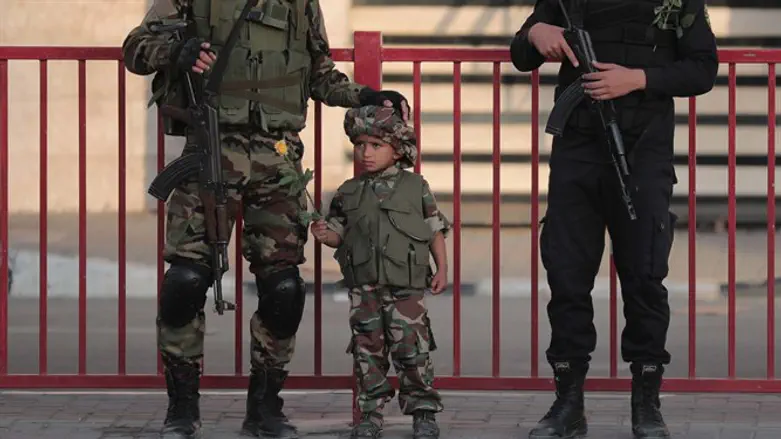
President Trump cannot help being willful and impulsive. He likes to call the shots; whatever advised to do he does the opposite. Critics think because he is not obedient he’s a brute. But despite or because of prickly traits, there’s been no incumbent of the White House more likely to bring down the curtain on a conflict that defies a deal.
Could the smirking face under the yellow coiffure make Israel and the Palestinians smoke the peace pipe?
It all depends. If ‘Mr Not Nice Guy’ is not blind to the elephant in the room he could be the one. He mustn’t be as myopic as, in his Trumpian brag, “All prior administrations from President Lyndon Johnson on, who tried and bitterly failed.”
Trump could do the impossible. But to do it he would have to spot that lurking mammoth. It alone knows what caused decades of peace proposals to be archived.
The peace camps haven’t a clue. They like to blame four problems of little bearing.
(1) Antipathy of Palestinian Arabs to the idea of a Jewish flag in the neighborhood;
(2) Israeli settlement building in the 'West Bank';
(3) Israeli "occupation"; and
(4) Palestinian Arab insistence on the time bomb labeled ‘Right of Return.’
Peace-seeking diplomats are so consumed by these blockers that the elephant in the room, signaling they’re wasting their time, goes unheeded. More’s the pity. The great blocker is nothing more complicated than money.
Money has institutionalized the Israeli-Palestinian conflict. Money has made it more an economic than a diplomatic problem.
How so?

Until the money tap is turned off no power on earth would impel super-rich, unaccountable leaders to smoke the peace pipe with Israel. No deal, miracle and all, would stop a money mechanism like no other on earth..The elephant in the room would hum and ha long after the diplomatic file had gone to the archives.
No deal, miracle and all, would stop a money mechanism like no other on earth..The elephant in the room would hum and ha long after the diplomatic file had gone to the archives.
You don’t stem billions of dollars, make a million jobs redundant and condemn thousands of activists to obscurity by brokering an agreement between two peoples. Yes, big fat beneficiaries sup at the table of the world’s favorite conflict.
At the head of the table sit kleptomaniac terror– crazies. Taps gushing dollars do not predispose the suits lording it over Ramallah and Gaza to make peace. Why would it? Why disturb a state of limbo if it meant no more filthy lucre. Billions of dollars, with no strings attached, have gushed into the coffers of Hamas and the Palestinian Authority. That’s only from Western donors. How much Arab countries and Iran have sent is anyone’s guess.
Largesse never incentivized leaders to get up and do something. Ask the World Bank. Its report in July 2012 complained that “the Palestinian economy cannot sustain statehood as long as it continues to rely heavily on foreign donations.” So on what did Palestinian leaders splash billions?
Some of it went to pay some 140,000 workers that swell its payroll.’ They are the breadwinners for a third and more of the Palestinian population. Nearly half work in security, which has a sufficiently broad meaning to allow militants of the Al-Aqsa Martyrs Brigade, Islamic Jihad and other groups to draw a salary.
If they happen to be behind bars, still they get their monthly transfer. Mahmoud Abbas uses around 6% of the budget to keep ‘political prisoners’ and convicted murderers in clover. In this upside down world prisoners never go short, while teachers and health workers are left waiting for their money.
More billions go into ‘development aid’, though what this means depends on what cronies ensconced in Ramallah and Gaza City like it to mean. Other billions go down a few deep pockets.
“Chronic Kleptocracy – Corruption within the Palestinian Political Establishment” was the title given to a hearing of the House Committee on Foreign Affairs held in July 2012. Analysts testified before Congress on crony capitalism, endemic corruption, distortions of the market and other malpractices.
For Gaza, aid from abroad is the economy. Under the PLO much of it came from the US and Europe, but after Hamas came to power the Arab League was forced to step in. Iran on its own has become an important donor, funding Hamas to the tune of hundreds of billions. Since there can hardly be tax revenue from an economy with practically no taxpayers, reliance on donations must be total. On what, and on whom, the money is spent no one knows, and cares even less.
Until the money tap is turned off no power on earth would impel super-rich, unaccountable leaders to smoke the peace pipe with Israel.
And how, unless by the hand of God, will Team Trump decommission a planetary system? If two states do get born from the ‘Deal of the Century,’ what happens to the orbiting bodies? So many livelihoods; all the reputations and careers; such behemoth planets and moons, so much wild spending, orbit the conflict.
Take UNWRA. When the UN agency began in 1950 it had three quarter million Palestinian refugees to care for. Today it looks after some five million. There are 700 UNWRA schools teaching half a million children; 122 clinics and more welfare centres provide better care than Arab host countries offer their citizens. But it doesn’t come cheap. UNWRA’s budget is around $2 billion.
What if the miracle happens? What if the Trump formula gets accepted by the side that has said, “No – a thousand times no?’ How would UNWRA workers react – some 30,000 Palestinians who believe in entitlement as they believe in Allah? Just talk of cutbacks led to riots in the territories.
And no one in their right mind expects Arab leaders to surrender their potent weapon against Israel: refugees. Lebanon, Syria and Jordan putting up their hands to absorb five million? It won’t happen. For seven decades Palestinian refugees haven’t known what human rights mean. No deal made in Jerusalem and Ramallah can change that.
Who the will continue to look after the millions in permanent limbo? No force known to man could make the United Nations disband UNWRA.
Other bodies, playing for bigger money, orbit the conflict. Who’d bet on the human rights industry supporting the peace plan and packing up. This is an industry in every sense of the word. Look at the sustainability factors driving the civil society businesses (NGOs): mountains of cheap capital; global reach, well-connected stakeholders, media channels beating a path to the door, and last but not least: a traded commodity called Israeli misdeeds, for which the world has a gluttonous hunger. If those are not conditions for big business what are they?
Nominally NGOs are autonomous, not-for-profit and apolitical. In real life they are none of those things. There are not hundreds but thousands of entities, a bewildering number of them operating in the tiny areas of Israel and the West Bank, all competing to supply human rights product. And on the industry people depend for jobs, in their tens of thousands.
Trade is brisk, the money big and the players earnest. There are billionaire private investors, Euro zone countries that practically fling money at NGOs, ecumenical coffers, flush Arab potentates and proverbial Joe public. The Ford Foundation is one of the bigger investors, with an annual grant budget exceeding $500 million. Christian Aid, with branches in 50 countries, brings in €100 million and more a year, while Human Rights Watch received $100 million for 10 years from George Soros. Oxfam is bigger than them all. With affiliates it attracts €900 million annually, a third of that from Euro Zone tax money.
These and lesser NGOs operate a particular business model which gives them a vested interest in human right abuses. Real or not is not important. Israeli misdeeds are levered as stock-in-trade; they are assets convertible into cash.
Exactly how popular is the Israeli brand? One of the big-five, Human Rights Watch, devotes three times more resources to policing and reporting Israel than to Iran, Saudi Arabia and the Palestinian Authority combined, and six times more resources than to Syria and Libya. Amnesty produces 255 reports per million Israeli people compared to 60 reports on Syria, 23 on Iraq and Iran, and a mere 9 on Saudi Arabia.

And the king of human rights kings? The United Nations trades in hardly anything but the Israeli brand. When the Syrian regime slaughters 70,000 of its own people, Oxfam pays lip service by issuing three statements. At the same time Oxfam condemns Israel, stable and free and going about its business, nine times.
When the Syrian regime slaughters 70,000 of its own people, Oxfam pays lip service by issuing three statements. At the same time Oxfam condemns Israel, stable and free and going about its business, nine times.
And the king of human rights kings? The United Nations trades in hardly anything but the Israeli brand. Seventy five percent of that body’s condemnations and sixty percent of its emergency sittings relate to Israel. For human rights violations in the whole world the UN keeps just one permanent item on the agenda. It keeps one other permanent item for Israel alone.
Not to leave out the foot soldiers. How will boycotters take a deal that absolves the country they love to hate? Would they accept an Israel that comes up smelling of roses? Limelight, book sales, career opportunities and, for the lucky few celebrity status, would evaporate like the dew after dawn. Take away the unresolved conflict and you break the magic money machine. ‘Israel-bashing is the contemporary key to acceptance,’ said Professor Robert Wistrich.
Even a humble saxophone player may aspire to overnight celebrity status. ‘It is Gilad Atzmon’s blunt anti-Zionism rather than his music that has given him an international profile,’ the Guardian explains.
Good luck and all to a President half the world loves to hate. Were Trump to smash the blocker of peace, a Nobel Prize would be a miserly reward.

